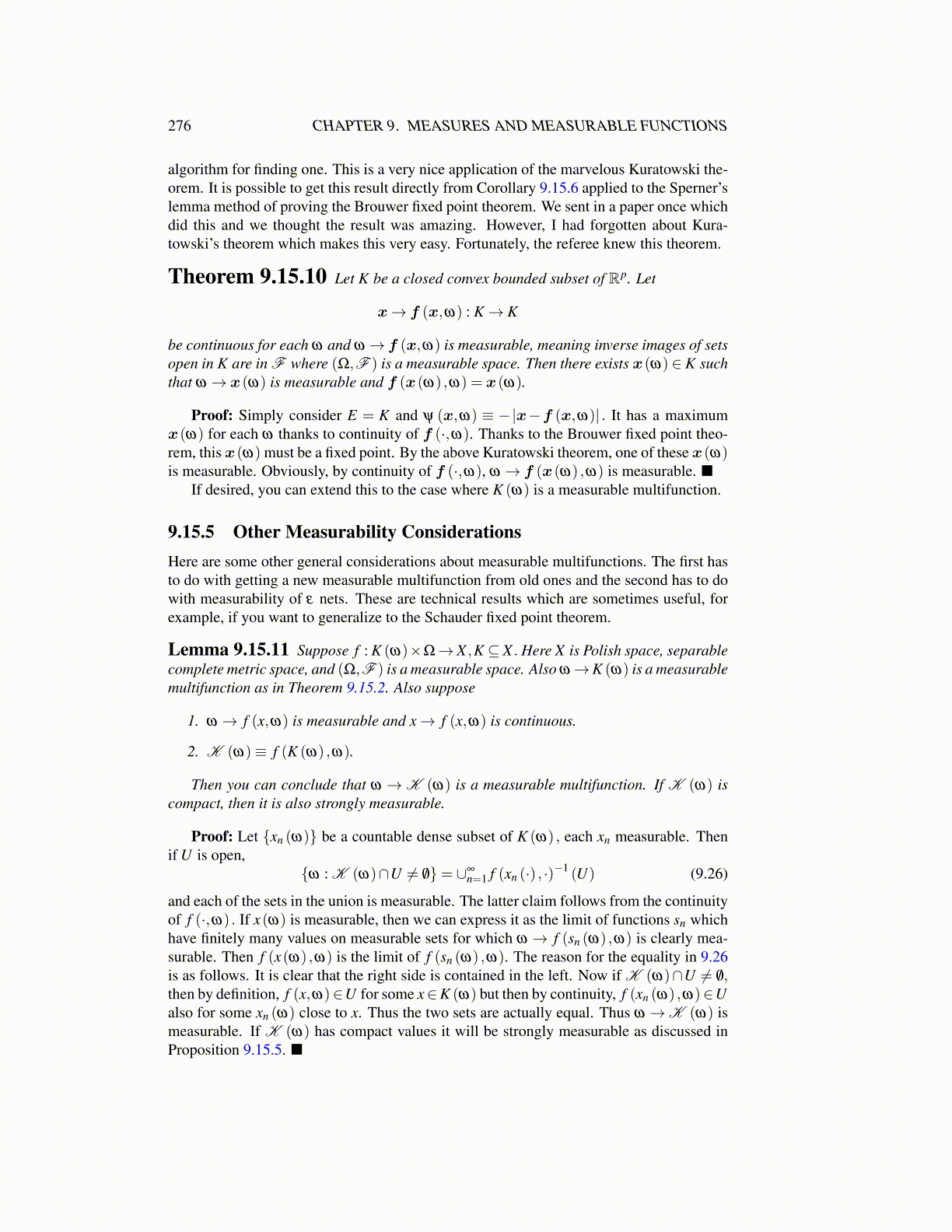
276 CHAPTER 9. MEASURES AND MEASURABLE FUNCTIONS
algorithm for finding one. This is a very nice application of the marvelous Kuratowski the-orem. It is possible to get this result directly from Corollary 9.15.6 applied to the Sperner’slemma method of proving the Brouwer fixed point theorem. We sent in a paper once whichdid this and we thought the result was amazing. However, I had forgotten about Kura-towski’s theorem which makes this very easy. Fortunately, the referee knew this theorem.
Theorem 9.15.10 Let K be a closed convex bounded subset of Rp. Let
x→ f (x,ω) : K→ K
be continuous for each ω and ω→ f (x,ω) is measurable, meaning inverse images of setsopen in K are in F where (Ω,F ) is a measurable space. Then there exists x(ω) ∈ K suchthat ω → x(ω) is measurable and f (x(ω) ,ω) = x(ω).
Proof: Simply consider E = K and ψ (x,ω) ≡ −|x−f (x,ω)| . It has a maximumx(ω) for each ω thanks to continuity of f (·,ω). Thanks to the Brouwer fixed point theo-rem, this x(ω) must be a fixed point. By the above Kuratowski theorem, one of these x(ω)is measurable. Obviously, by continuity of f (·,ω), ω → f (x(ω) ,ω) is measurable. ■
If desired, you can extend this to the case where K (ω) is a measurable multifunction.
9.15.5 Other Measurability ConsiderationsHere are some other general considerations about measurable multifunctions. The first hasto do with getting a new measurable multifunction from old ones and the second has to dowith measurability of ε nets. These are technical results which are sometimes useful, forexample, if you want to generalize to the Schauder fixed point theorem.
Lemma 9.15.11 Suppose f : K (ω)×Ω→ X ,K ⊆ X . Here X is Polish space, separablecomplete metric space, and (Ω,F ) is a measurable space. Also ω→K (ω) is a measurablemultifunction as in Theorem 9.15.2. Also suppose
1. ω → f (x,ω) is measurable and x→ f (x,ω) is continuous.
2. K (ω)≡ f (K (ω) ,ω).
Then you can conclude that ω →K (ω) is a measurable multifunction. If K (ω) iscompact, then it is also strongly measurable.
Proof: Let {xn (ω)} be a countable dense subset of K (ω) , each xn measurable. Thenif U is open,
{ω : K (ω)∩U ̸= /0}= ∪∞n=1 f (xn (·) , ·)−1 (U) (9.26)
and each of the sets in the union is measurable. The latter claim follows from the continuityof f (·,ω) . If x(ω) is measurable, then we can express it as the limit of functions sn whichhave finitely many values on measurable sets for which ω → f (sn (ω) ,ω) is clearly mea-surable. Then f (x(ω) ,ω) is the limit of f (sn (ω) ,ω). The reason for the equality in 9.26is as follows. It is clear that the right side is contained in the left. Now if K (ω)∩U ̸= /0,then by definition, f (x,ω)∈U for some x∈K (ω) but then by continuity, f (xn (ω) ,ω)∈Ualso for some xn (ω) close to x. Thus the two sets are actually equal. Thus ω →K (ω) ismeasurable. If K (ω) has compact values it will be strongly measurable as discussed inProposition 9.15.5. ■